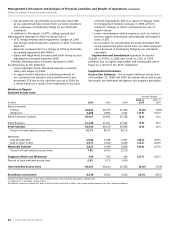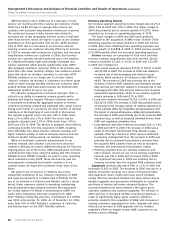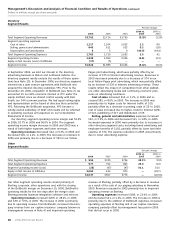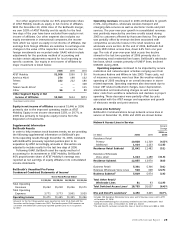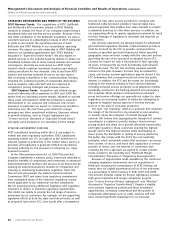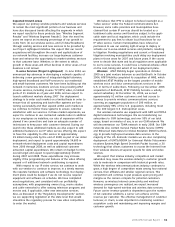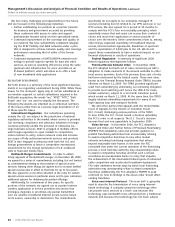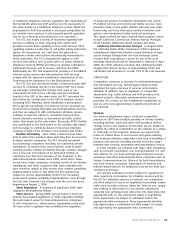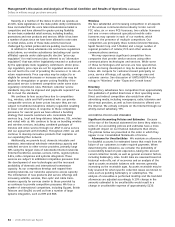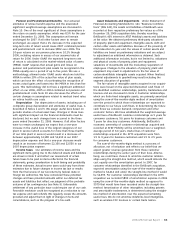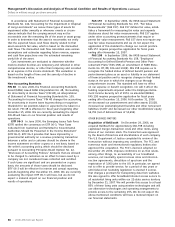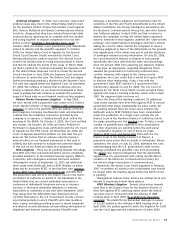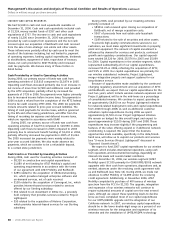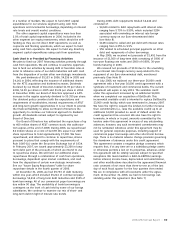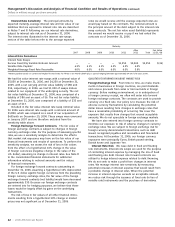AT&T Wireless 2006 Annual Report Download - page 35
Download and view the complete annual report
Please find page 35 of the 2006 AT&T Wireless annual report below. You can navigate through the pages in the report by either clicking on the pages listed below, or by using the keyword search tool below to find specific information within the annual report.
2006 AT&T Annual Report : :
33
to traditional telephone industry regulation. But, depending on
the bandwidth allocated, VoIP services are not necessarily of
the same quality as a traditional telephone service. While the
deployment of VoIP has resulted in increased competition for
our wireline voice services, it also presents growth opportuni-
ties for us to develop new products for our customers.
The FCC has issued a variety of decisions regarding VoIP
services, including an order requiring that certain VoIP
providers include E911 capability in their VoIP services. E911
capability enables a subscriber to call public safety authorities
(police, fire department, etc.) and have the subscriber’s
telephone number and location automatically transmitted to
those authorities. The FCC’s requirement applies to VoIP
services that allow a user to send calls to a public switched
telephone network (PSTN), including our wireline subsidiaries’
traditional networks, and to receive calls from the PSTN.
Additionally, the FCC has required that providers of broadband
Internet access service and interconnected VoIP services
comply with the electronic surveillance requirements of the
Communications Assistance for Law Enforcement Act.
The FCC has also directed providers of interconnected VoIP
services to contribute directly to the federal USF. As a result,
we will begin collecting USF charges from users of our
interconnected VoIP service offerings and will contribute
directly to the USF. In the same order, the FCC increased the
safe harbor for contributions to the USF by wireless carriers
(including AT&T Mobility), which establishes a presumption
that a specific percentage of a wireless carrier’s revenues are
derived from providing interstate telecommunications services,
and thus are subject to USF contributions. Wireless carriers
continue to have the option to contribute based on their
actual interstate revenues as determined by traffic studies
rather than based on the safe harbor. Previously, AT&T Mobility
has contributed to the fund based on the wireless safe harbor
but has begun to contribute based on its actual interstate
revenues in light of the increase in the wireless safe harbor.
Number Portability Since 1999, customers have been
able to retain their numbers when switching their local service
between wireline companies. The FCC allowed incumbent
local exchange companies, including our traditional wireline
subsidiaries, to recover their carrier-specific costs of imple-
menting wireline number portability through customer charges
over a five-year term based on an estimated number of
customers over that term. Because of the downturn in the
telecommunications market since 1999, which led to fewer
access lines, many companies, including certain of our wireline
subsidiaries, had fewer customers than were estimated and
were therefore unable to fully recover their number portability
implementation costs. In July 2006, the FCC granted our
request to recover approximately $190 of our remaining,
unrecovered number portability implementation costs through
the End User Common Line charges over the next two years
beginning on August 1, 2006.
State Regulation A summary of significant 2006 state
regulatory developments follows.
Video Service During 2006, several states in which we
operate have passed legislation or made regulatory findings
that will make it easier for telecommunications companies
to offer television (i.e., video) service. Depending on the state,
the laws and/or regulators have prohibited the regulation
of advanced services, broadband, information and certain
IP-enabled services and commercial mobile services; have
provided clarity on the public utilities’ authority over video
franchising; and have addressed nondiscrimination obli-
gations and mandatory facility build-out provisions.
The states in which we have received these positive actions
include California, Connecticut, Indiana, Kansas, Michigan,
North Carolina, Oklahoma, South Carolina and Texas.
California Intrastate Access Charges In August 2003,
the California Public Utility Commission (CPUC) opened a
rulemaking to determine whether certain elements of state
access charges (charges that our local exchange carrier
receives from long-distance carriers for use of the local
exchange network) should be eliminated or reduced. In April
2006, the CPUC adopted a decision that eliminated certain
charges (lost annual revenue of approximately $130) and
authorized rate increases to recover 75% of the lost revenues.
COM PET I TIO N
Competition continues to increase for telecommunications
and information services. Technological advances have
expanded the types and uses of services and products
available. In addition, lack of regulation of comparable
alternatives (e.g., cable, wireless and VoIP providers) has
lowered costs for alternative communications service
providers. As a result, we face heightened competition as
well as some new opportunities in significant portions of
our business.
Wireline
Our wireline subsidiaries expect continued competitive
pressure in 2007 from multiple providers in various markets,
including wireless, cable and other VoIP providers, interex-
change carriers and resellers. At this time, we are unable to
quantify the effect of competition on the industry as a whole,
or financially on this segment. However, we expect both
losses of market share in local service and gains resulting
from business initiatives, especially in the area of bundling of
products and services, including wireless and video, large-
business data services, broadband and long-distance service.
In some markets, we compete with large cable companies,
such as Comcast Corporation, Cox Communications, Inc. and
Time Warner Inc., for local and high-speed Internet services
customers and other telecommunications companies such as
Verizon Communications Inc. (Verizon) for both long-distance
and local services customers. Substitution of wireless and
Internet-based services for traditional local service lines also
continues to increase.
Our wireline subsidiaries remain subject to regulation by
state regulatory commissions for intrastate services and by
the FCC for interstate services. In contrast, our competitors
are often subject to less or no regulation in providing compa-
rable voice and data services. Under the Telecom Act, compa-
nies seeking to interconnect to our wireline subsidiaries’
networks and exchange local calls enter into interconnection
agreements with us. Any unresolved issues in negotiating
those agreements are subject to arbitration before the
appropriate state commission. These agreements (whether
fully agreed-upon or arbitrated) are then subject to review
and approval by the appropriate state commission.



